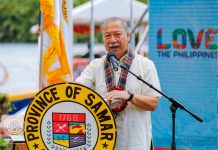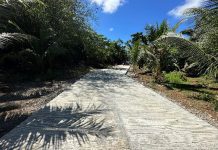CATBALOGAN CITY- Officials from the three Samar provinces are calling for the expansion of areas to be covered under the Payapa at Masaganang Pamayanan (Pamana) program.
Areas identified under the Pamana program, which is being implemented by the Office of the Presidential Adviser on Peace Process (OPAPP), receives funding for construction of roads. These areas are remote and affected with insurgency problem.
Samar Governor Sharee Ann Tan, who chairs the Regional Peace and Order Council (RPOC), said that there is a clamor from other officials of the three Samar provinces to expand the number of areas presently covered under the Pamana program.
At present, there are only 10 areas in Samar, Eastern Samar, and Northern Samar provinces that are under the Pamana project.
These are San Jose de Buan and Matuguinao, both in Samar; Silvino lobos, Las Navas, Catubig, Lope de Vega, San Roque and Mondragon in Northern Samar and Maslog and Jipapad, both in Eastern Samar.
It was learned that the provincial governments of Northern and Eastern Samar through their respective provincial board passed resolutions calling to include other areas of their respective provinces.
In the case of Eastern Samar, they have identified the towns of Arteche, Oras, Dolores, Can-avid, San Julian, Hernani, Llorente, Gen Macarthur and the city of Borongan to be included in the Pamana program.
Last year, OPAPP earmarked P447 million for the implementation of Pamana projects in the identified areas. The national government allotted P20 billion for Pamana projects across the country for the same year.
Gov. Tan said that the declaration by the military several towns in Samar provinces as insurgency-free has resulted for the government to reduce the funding of projects under Pamana.
“I am really sensitive in the declaration of insurgency-free. Yes, I know that there are areas that is free from insurgency but there are also areas where insurgency movement presence is still being felt,” Tan said.
The move of the military in 2015 declaring most areas of the province as insurgency-free was greatly opposed by the provincial government which prompted the Armed Forces of the Philippines to conduct a review.
“I always raise this issue during my discussion with top officials of the AFP and the Philippine National Police not to sugarcoat the situation just because of there is a directive from the higher-ups. I always tell them to assess the real situation on the ground before issuing such declaration,” Tan added.
Pamana Samar area manager Emilda Bonifacio advises the local leaders in Samar provinces to hasten the submission of their recommendation of areas they think need to be included under the Pamana program.
“Until now we do not have yet the complete listing of the Pamana areas. As of now only 10 LGUS in Eastern Visayas are included in the list of Pamana areas. Most of the projects that we are focusing on are on these 10 areas,” Bonifacio said.
Bonifacio added that the declaration of insurgency-free status has resulted for the region to receive a lower budget for Pamana projects.
“I think this will need to be revalidated if the information is true. It would be better if we will base our information from the ground than base it from the central office,” Bonifacio said.
She added that aside from insurgency problem, their agency is also looking to include poverty as basis for a municipality to be identified as a Pamana area.
(ROEL T. AMAZONA)



